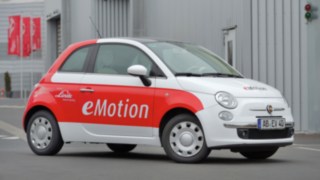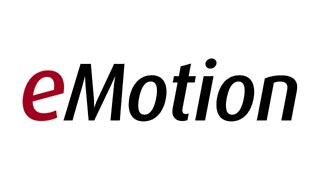The future of e-mobility
Ready, set, go!
Electromobility—or e-mobility—is the buzzword that everyone’s talking about. As Head of Linde eMotion, no-one knows that better than Wolfgang Klüpfel. He and his team take electric series drives from Linde forklift trucks and re-purpose them for other vehicles. In this interview, he discusses which projects can prove particularly tricky, why companies are sometimes guilty of neglecting electrification, and the technology capable of resolving all the challenges around e-mobility.
Mr. Klüpfel, what do you like best about your job?
Everything about my job is great fun— it’s hard to imagine a more varied role. We develop technical solutions, work in close consultation with customers, have responsibility for sales, and even develop exciting marketing campaigns. The range of tasks is so varied that it’s impossible to be bored. Even though our team is part of a large company like Linde Material Handling, our mentality is very much that of a start-up. I find that really refreshing!
What is your favorite Linde eMotion project to date?
The electric kartsthat we developed in collaboration with Italian kart manufacturer CRG. Everything about that project ran smoothly: We designed the whole electric drive and were able to implement everything exactly as the customer had planned. During the test phases and commissioning, we enjoyed some exhilarating test rides in the karts, which were also very informative. The karts were a fantastic success for everyone involved and are still available to hire at karting tracks around the world. The electric karts project ticked all three boxes for our main requirements for a project: The technology must be exciting and innovative, the project must be commercially viable, and there must be a clear benefit in terms of marketing.

Electric kart developed by Linde Material Handling and Italian kart manufacturer CRG

Electric kart developed by Linde Material Handling and Italian kart manufacturer CRG
What is the trickiest problem the e-Motion engineers have had to solve to date?
That’s a hard one. The projects are always more complicated when we are asked to electrify a vehicle that is new to us. Every sector has its own guidelines, standards, and requirements which our technology and documentation must comply with. For instance, construction machinery is governed by very different rules to farming machinery, and likewise there a differences between municipal vehicles and private cars.

Fiat 500 with electric drive developed by Linde Material Handling

Fiat 500 with electric drive developed by Linde Material Handling
This is a major challenge, but one that we have so far managed to overcome every time. For instance, in 2011, we fitted a Fiat 500 with an electric drive for the company Karabag and the finished product was approved by the TÜV (German Technical Inspection Association) without any difficulty.
Lots of people are talking about e-mobility at the moment, which is generating a certain amount of social pressure to take action. Are you noticing that in your day-to-day work?
More industries are starting to look into e-mobility, as evidenced by the number of inquiries we have recently received from customers. E-mobility has become a major focus for the construction and agricultural sectors. At Linde we have been constructing electric series drives for the last 45 years, but these industries have a lot of catching up to do. At trade fairs, you often see pilot projects for electric vehicles but very few of these actually make it to series production. Companies are testing lots of ideas, but to date very few product lines have been converted to electric drives on a large scale.
What is the reason for that?
These companies, like all companies, are governed by the economic situation. As soon as any economic slowdown hits, innovation projects are the first to be put on hold. If the economic outlook appears insecure, car manufacturers concentrate on their core business, which is generally vehicles with combustion engines. That’s normal. Companies have to make money, and you make money with proven technologies, where you have a good handle on the processes and production methods and complete confidence in the R&D strategy. Everything else is secondary to this.
When it comes to electrification, Linde is already one step ahead, along with a few other car manufacturers. Are there any synergies?
Private cars and commercial vehicles have traditionally been separate sectors, and that will remain the case in future. Of course, the e-mobility technologies are the same, but the automotive industry and its suppliers generally have different R&D goals. New car models need to be brought to market quickly, be produced in large volumes, and be affordable for individual customers. That’s why car manufacturers generally prefer to develop their technologies themselves. Nonetheless there are some examples of knowledge-sharing through the VDMA – German Mechanical Engineering Industry Association or the Drive Technology Research Association. These sources are interesting and informative but do not always use their own research.
How do you rate the latest technologies that are currently available? Will we all soon be driving electric vehicles?
A lot of the current R&D work is focusing on battery performance. However widespread e-mobility, based purely on battery technology, is not possible with current technology. Firstly we can’t generate enough energy for all the vehicles, and secondly the batteries do not charge fast enough. It takes at least ten times longer to charge the battery in an electric car than to fill the tank. And we all know how problematic rush hour on major roads can be, without also having to wait in long queues to fill up with petrol or diesel.

In my opinion, given the threat posed by climate change, there are only a few technologically viable solutions.
Wolfgang Klüpfel, Head of Linde eMotion
What are they?
One is fuel cell hybrids. These are drive systems with a hydrogen fuel cell and lithium-ion battery. A fuel cell vehicle is an electric vehicle that uses hydrogen as an energy source. By using electricity from renewable sources, it is possible to produce hydrogen using a CO2-neutral electrolysis process. The fuel cell converts the hydrogen into electrical energy, which drives the vehicle’s electric motor. The battery provides backup storage. It delivers the required top performance and is more dynamic than the fuel cell. This type of drive is entirely climate neutral.
How could this technology be integrated into everyday vehicles?
For short journeys, the energy density of the lithium-ion battery would be completely sufficient; for longer journeys the vehicle would be refueled at hydrogen filling stations. This is an entirely green mobility model that would be easily accepted by drivers as they would simply need to refuel as they do now. The refilling station infrastructure would need to be put in place, but this is not much more complicated than for diesel and petrol. All the technological groundwork is already in place. We just need to press the starting gun.
How long would it take to implement?
The VDA [German Association of the Automotive Industry] and VDMA [German Mechanical Engineering Industry Association] are working on the assumption that manufacturers will start to launch fuel cell vehicles on the market in large volumes from around 2030. In the logistics sector, for instance in the case of Linde forklift trucks, we are already seeing an increase in demand. This is because industry does not need to first solve the problem of a country-wide filling station infrastructure. With just one hydrogen filling station on site, companies can refuel their entire fleet.
Where do Linde and eMotion stand in terms of fuel cells?
Linde was the first European company in our sector to look into this technology, and we have had viable solutions ready for use since the year 2000. Slowly but surely, customers are starting to see fuel cell hybrids as the future of e-mobility— and we are ready for this.
Mr. Klüpfel, thank you very much for your time.
